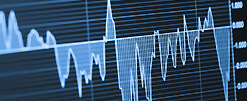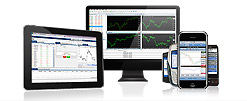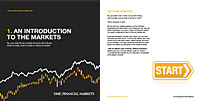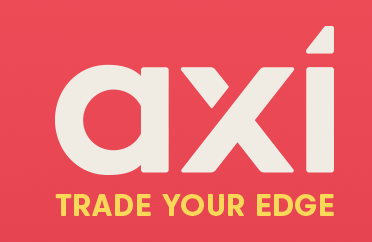2. What is CFD Trading?
A contract for difference (or CFD) is a contract between two parties; Axi is the market maker in this situation and will be the buyer to anyone selling and the seller to anyone buying. The seller will pay to the buyer the difference between the current value of an asset and its value at contract time. (If the difference is negative, then the buyer pays the seller.) In effect CFDs are financial derivatives that allow investors to take advantage of prices moving up (long positions) or prices moving down (short positions) on underlying financial instruments and are often used to speculate on those markets.
- If the difference between the current and contract time value is negative, then the buyer will pay the seller.
- If the difference is positive, then the seller will pay the buyer the difference in the values.
There is…
- No restriction on the entry or exit price of a CFD.
- No time limit on when this exchange happens.
- No restriction on buying or selling first.
CFDs are often traded on what is called leverage [don’t worry we’ll get to this a bit later on] to give traders more trading power, flexibility and opportunities. For the mean time, let’s just keep it simple with the following example:
The Agreement:
- Person A believes Gold is going to rise from $1,175.00 per oz
- Person B believes Gold is going to fall from $1,175.00 per oz
Therefore the two clients enter an agreement to settle the difference from $1,175.00.
The Outcome:
- Person A Buys 1 oz of Gold at $1,175.00
- Person B Sells 1 oz of Gold at $1,175.00
After 3 days, Gold is trading at $1,180.00 showing Person A profit of $5 on his oz and person B a loss of $5
- Person A Closes the position at $1,180.00 and makes $5
- Person B Closes the position at $1,180.00 and loses $5
That example makes CFDs look pretty simple, and that's because, well, they are. Trading CFDs isn’t all that different from trading traditional shares;
- If you buy 500 shares of a company at £5 then you have £2500 of stock.
- If you buy 500 shares with a CFD at £5 then you also have £2500.
- If the share price rises by 10% then you have made £250 from your share trade.
- If the share price rises by 10% then you have made £250 from your CFD trade
Now you’re thinking, well if the value is the same, the profit is the same, the loss is the same, the risk is the same, then why trade CFDs?
Read “Advantages of CFD Trading” below to find out
Profit and Loss Calculations
The Profit or Loss for a CFD can be calculated using a very simple formula;
P/L = (Sell Price* - Buy Price*) x No. of CFDs
*Without decimal point
It doesn’t matter if you bought or sold first, the profit on a CFD is the difference between the buying and selling price. It’s just that simple!
You will find plenty of examples of P/L calculations in the remainder of this document.
Make profit from a falling market
With CFDs you can benefit whether the price of an instrument is falling or rising. As we mentioned earlier there is no restriction on opening a position with a buy or a sell in CFD trading.
Entering a position with a buy sell, which you would do if you thought the market was falling, is called short selling and allows you to sell a position first and then buy it back at a lower price.
An example using our simple P/L formula follows;
You sell 10 CFDs @ 60.30 [because you think the market is falling]
…and it does, so, to close your trade…
You buy 10 CFDs @ 58.85
| Therefore your P/L would be… | ||||
| P/L | = | (6030-5885) | x | 10 |
| = | 145 | x | 10 | |
| = | $1450 | |||
Trade on a wide range of markets
With CFDs you are not limited to a specific asset class; you can trade all your favourites with CFDs. With One Financial you can trade CFDs on:
- Foreign Exchange (Forex or FX)
- Commodities
- Indices
- Equities
- Bullion
No Stamp Duty
Whenever you buy a share, you have to pay the government 0.5% of the value of your trade. Well not with CFDs; unlike other investments there is no stamp duty to pay on a CFD trade.
Margin flexibility
CFDs are traded on what we call margin. This means that you can take a large position in the market without having to deposit the full contract value.
For example One Financial Markets offers a leverage of 400:1 on FX meaning that you could leverage a $2,500 deposit to trade $1 million!
We will come on to some worked examples of margin and leveraging later on in our training.
But for the moment all you really need to know is that leverage is a really efficient use of your capital and leaves your equity free to trade in various other transactions.
The Potential Pitfalls of CFD trading
CFDs can be a risky business; as we have said before, leverage allows you to take positions that are larger than your deposit size. It means you can potentially make large profits but also means that the risk of large losses is greater.
If you are a beginner then the most important thing is to manage your risk. In fact managing your risk is so important that we’ve dedicated an entire module to explaining how to do it.
Bullion
Bullion is Gold and Silver and the demand for Bullion isn't driven only by their practical use, but also by their role as investments and a store of value. Paper currencies come with all sorts of problems, like the risk of being inflated in times of political and economic turmoil, and this can have a negative influence on their investments. Gold and Silver are safer bets in this respect because their value doesn't rely on any particular government’s health and so issues like inflation and economic downturn don't really have as much of an effect.
When trading Bullion via a CFD, you don’t take delivery of Gold or Silver so the difference in the price between the buy and the sell price will be cash settled.
Factors that influence bullion prices
Like pretty much all other investments and commodities, the price of Gold and Silver is driven by supply and demand. Given that most of the Gold and Silver ever mined still exists and can therefore potentially come back on to the market, it’s changes in sentiment more than changes in production or jewellery demand that will affect the price.
Economic Factors
- Low/Negative real interest rates: During times of low or negative real interest rates when significant inflation is present and interest rates are relatively low investors will seek the safe haven of bullion to protect their capital.
- War: In times of great uncertainty, particularly when war is feared, the demands for bullion increases as investors see bullion as a solid investment which will always have a stable value in any country.
- Sentiment: It used to be said that ‘Gold is the world’s frightened bunny’. Whenever crises threatened the demand for physical bullion increases.
Opening Times
We quote bullion at 23:00 Sunday London time until 21:00 Friday London time. We offer prices in Bullion 24 hours a day during this period apart from a daily exchange break at 22:00 – 23:00 for Spot products and 22:15 – 23:00 for future products.
Indices
A stock market index is a listing of stocks and a statistic reflecting the composite value of its components. It is essentially a fictitious portfolio of securities that represent the whole, part or the best performing part of the market. All stocks in an index will have something in common, they’ll belong to the same industry for example, and the index is a tool to represent the characteristics of all these stocks.
There are also what is called specialised indices; these indices allow you to track the performance of a specific sector, but more often, the indices that will be offered are the broader indices that cover the main stocks in the market. A broad-based index represents the performance of a whole stock market and reflects investor sentiment on the state of the economy. Indices may sound like a confusing thing, but you’ve definitely come across them before; the most regularly quoted market indices are made up of the stocks of large companies listed on a nation's largest stock exchanges, such as the American Dow Jones Industrial Average and S&P 500 index, the British FTSE 100, the French CAC 40, the German DAX, the Japanese Nikkei 225 and the Hong Kong Hang Seng Index.
Factors that influence indices
An index will reflect the general health and stability of that country’s economy and will be affected by the countries industrial and political status. It is worth remembering that a country’s index is directly linked with the relative strength of that country’s currency; because it is its currency that will determine a company’s competitiveness on the international scene.
Industrial Factors
- Trade Balance: This is the difference between the monetary value of exports and imports over a certain period of time. A positive balance is known as a trade surplus and means more goods have been exported than imported. The opposite is what we call a trade deficit. The key figure here is the export figure because an increase in this means either a strengthening competitive position at home and/or strengthening economies overseas are boosting the home country’s growth.
- Industrial Production: Output for key industrial sectors such as manufacturing, mining and utilities are highly sensitive to consumer demand and interest rates. This means Industrial Production is also key when forecasting economic performance and growth. In fact it’s so important that it’s even used by central banks to measure inflation because high levels of industrial production can lead to uncontrolled levels of consumption which then leads to inflation.
- Relative Currency Strength: This will determine the competitiveness of a company to compete in the international arena. If the home country’s currency is strong then wages and production costs are going to be higher so to ensure a profit the cost of the end product is going to get higher too.
Political Factors
Political factors are important. They’re interwoven with economic conditions for many investors when making investment decisions; and include things like the political and social stability in a country, government policies, regulatory environment and central bank intervention.
Indices in-hours pricing
Often market makers such as One Financial Markets will have prices that are different to the prices quoted at the exchange. This is because the underlying contract will be a future and for example we offer a rolling spot product. A concept called fair value is used to turn an index futures price into an equivalent spot price by removing the cost of carry effect involved in the price [such as dividends, interest rates etc.]
If the concept of fair value is still not too clear then maybe the following example will make it easier to grasp;
LIFFE FTSE last trade is 6850
Fair value is -10
Market maker’s price is 6839-6841 (built with a 2 pip spread around the new cash price of 6840)
These fair values are monitored by the dealers to ensure that our prices are relevant to the futures market.
You should also note that our prices may differ from the cash market that you will see quoted on Bloomberg, Reuters or any other reference source. This is because the cash price is calculated from a weighted addition of the prices of the constituent stocks. This can lead to a difference if a stock in an index is suspended or not trading correctly. One Financials price is therefore more accurate as it is a tradable instrument based on another traded instrument.
Foreign Exchange
The Foreign Exchange market (also commonly referred to as the FX, Forex or currency markets) is the single largest market in the world with an average of approximately $3.0 trillion worth of currency traded every day. The market exists whenever one currency is traded for another and consists of transactions between large banks, central banks, currency speculators, multinational corporations, governments and other financial markets and institutions. The FX market is an OTC (Over The Counter) market, in which participants trade via telephones and computer connections. One Financial Markets is one of the market makers that offer their own prices which are derived from various reputable counterparty feeds. We do not physically deliver currencies, but offer them on a contracts for difference basis, so that clients can speculate on the relative strength or weakness of a particular currency against another.
Factors that influence FX rates
Floating exchange rates are constantly changing and, like any other product, are influenced by the supply and demand for each currency. The factors that affect supply and demand can be generalised into 2 groups: Economic and Political.
Economic Factors
- Relative Interest Rates: An Interest Rate is the return an investor can make by lending money in that currency. It is apparent; therefore, that if an investor is able to receive an interest of only 3% in his domestic currency, but 6% in a foreign currency, that investor can increase his return by exchanging his money for the foreign currency and lending the money. The currency with the highest rates will tend to strengthen/appreciate as demand for it increases.
- Purchasing Power Parity (PPP): This is a measure of what equivalent goods cost in two different currencies. If the EUR/USD exchange rate is 1.1200, and the same car in France costs €8,000 and in America costs $11,000, it would be cheaper for someone in the US to import the car from France (ignoring the cost of importing, tariffs etc), as it would only cost €8,000 x 1.12 = $8,960. Therefore the country with the lower domestic PPP will tend to weaken/depreciate as the consumers seek cheaper foreign goods and consequently exchange their domestic currency for the foreign one.
- Economic conditions: If investors see opportunities to invest in a particular country, they will exchange their domestic currencies for the currency of that country, leading to the rise in the demand for the currency and hence the exchange rate. The elements that make international investors view conditions as favourable are complex and multifaceted, but include things such as GDP Growth, Inflation and taxation conditions.
Political Factors
Political factors are interwoven with economic conditions for many investors when making investment decisions; and include things like the political and social stability in a country, government policies, regulatory environment and central bank intervention.
Opening Times
We begin quoting Foreign Exchange prices at 22:00 Sunday London time until 22:00 Friday London time. We offer prices in currencies 24 hours a day during this period.
Of these three market categories FX is probably the one you had in mind when you decided to learn a bit more about trading. If you’re still not quite sure, or just want to know more about FX then take a look at the next module which is dedicated purely to the Foreign Exchange Market.









